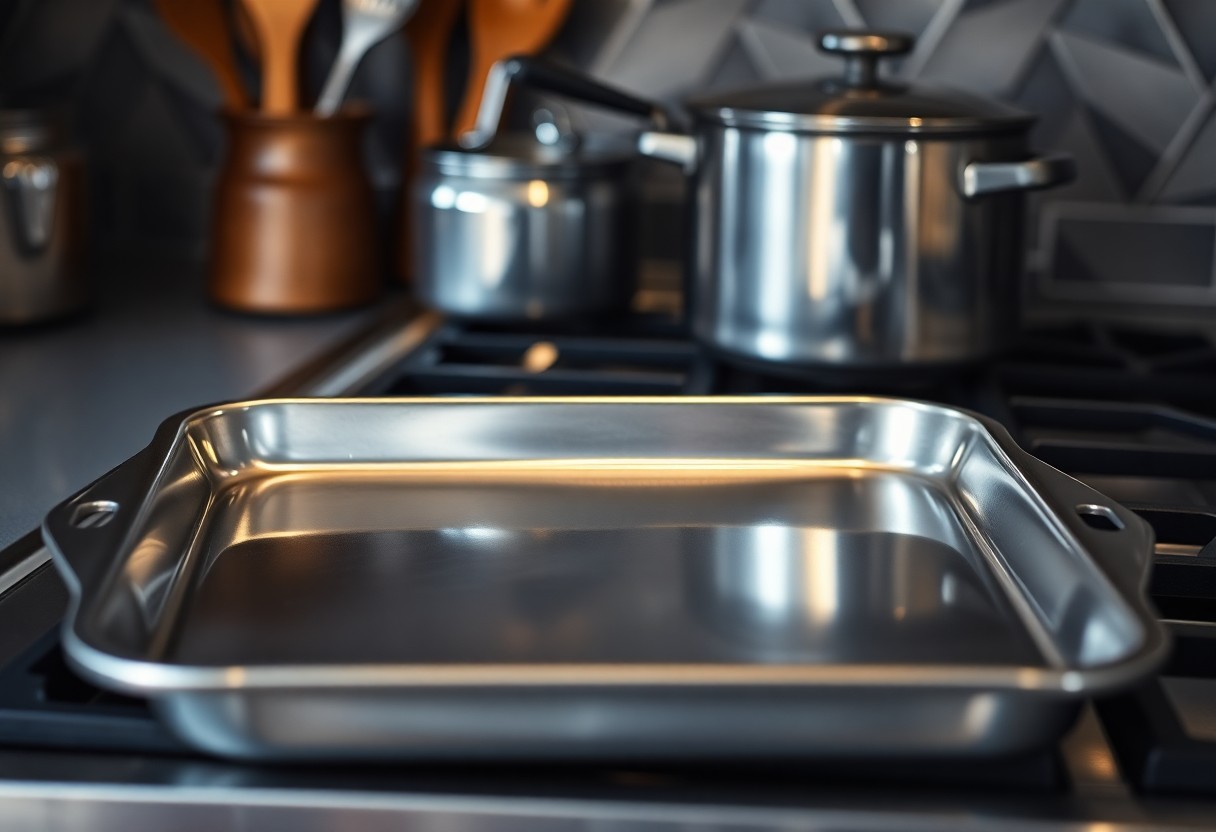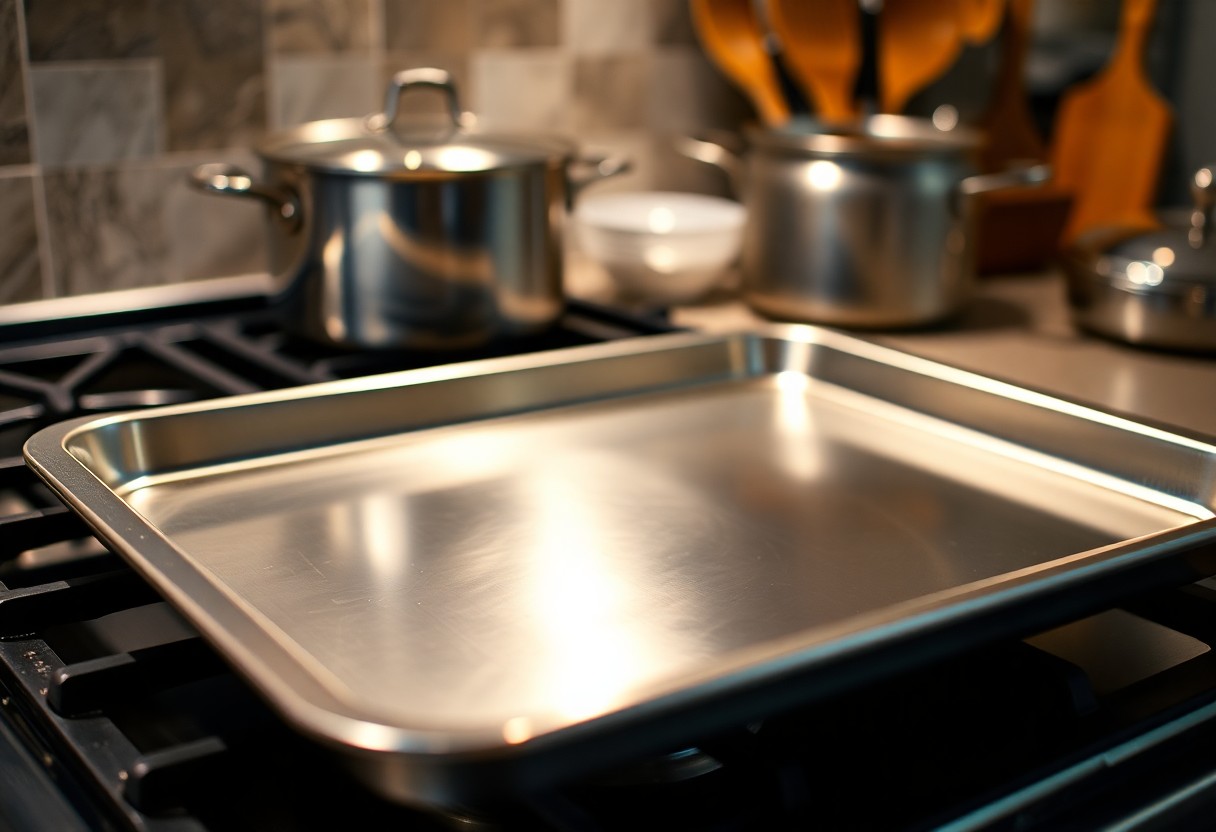Baking sheets are a staple in your kitchen, but can they safely be used on the stovetop? While it may be tempting to use your baking sheet for heating or cooking on the stove, caution is required. Most baking sheets are not designed to withstand the direct heat from burners, which can lead to warping or even fires. In this post, we’ll explore the appropriate uses for baking sheets and the potential hazards of using them on the stovetop, ensuring you can make the safest choices in your cooking adventures.

Key Takeaways:
- Baking sheets are typically not designed for stovetop use and can warp or damage under direct heat.
- Using a baking sheet on the stovetop could create uneven cooking results, as they do not distribute heat effectively like a skillet.
- If you need a flat surface for stovetop cooking, consider using a cast iron or stainless steel pan, which are more suitable for direct heat.

Understanding Baking Sheets
A baking sheet is an imperative kitchen tool, designed primarily for baking and roasting. Known for its flat shape and raised edges, it provides a stable surface for cooking various dishes, from cookies to vegetables. When dicking out a baking sheet, you’ll want to consider the material, size, and intended use to get the best results in your cooking adventures.
Materials Used in Baking Sheets
Around the kitchen, you will find baking sheets made from various materials, such as aluminum, stainless steel, and non-stick coatings. Aluminum sheets are lightweight and provide excellent heat conductivity, making them popular among bakers. Stainless steel, while heavier and less conductive, offers exceptional durability, whereas non-stick options are easy to clean and prevent food from sticking. Knowing the pros and cons of each can help you choose the right baking sheet for your needs.
Design and Functionality
At its core, the design of a baking sheet focuses on versatility and efficiency. The flat, rectangular shape allows for even heat distribution, ensuring that your cookies bake uniformly and that vegetables roast to perfection. Additionally, the raised edges—known as rims—help prevent spills and keep your food contained. You can often find varied sizes, enabling you to maximize your oven space and tailor your sheet for different recipes.
Hence, the functionality of a baking sheet extends beyond just its shape. The material you select directly influences your cooking results, while the design elements—like rim height—aid in moisture retention and help you achieve desired textures. Opting for a non-stick surface can make cleanup a breeze, but it’s imperative to follow proper usage guidelines to avoid damage. By understanding these design choices, you can enhance your cooking experience and achieve culinary success with your baking sheet.
Stovetop Cooking Methods
There’s a variety of stovetop cooking methods that you can easily explore, such as sautéing, boiling, and simmering. Each technique offers different benefits and can enhance your cooking experience. Knowing how to effectively utilize these methods allows you to prepare a wide range of dishes, from quick weeknight meals to more complex creations. Using the right cookware is imperative to ensure even heating and prevent any potential mishaps in the kitchen.
Potential Risks of Using Baking Sheets on the Stovetop
With the temptation to use a baking sheet on the stovetop, you should be aware of the potential risks involved. Baking sheets are often not designed for direct heat exposure, which can lead to warping, melting, or even causing unsafe fumes. Additionally, the lack of proper heat distribution may result in uneven cooking, potentially becoming a fire hazard. Prioritizing safety in the kitchen is paramount to avoid accidents or damage.
Alternatives for Stovetop Cooking
Among the safer alternatives for stovetop cooking, consider using cast iron skillets, stainless steel pans, or dedicated stovetop griddles. These options are designed specifically for high-heat cooking, ensuring both safety and efficiency. They provide better heat retention and distribution, allowing you to achieve perfectly cooked meals with ease.
In addition, using dedicated stovetop cookware not only enhances your cooking experience but also minimizes the risk of damage or accidents. Cookware made of materials like cast iron or stainless steel can withstand high temperatures without warping or releasing harmful substances. Investing in quality equipment tailored for stovetop cooking ensures that you can explore countless recipes safely and effectively, elevating your culinary skills while prioritizing your safety in the kitchen.
Safety Considerations
Now, it’s important to consider various safety factors when using a baking sheet on the stovetop. Stovetops generate intense heat, and using materials not designed for such environments can lead to accidents. Be mindful of any potential hazards, such as the risk of smoke, burns, or even fire. Always keep a close eye on your cooking and have a fire extinguisher nearby to ensure a safe cooking experience.
Heat Resistance and Conductivity
With baking sheets varying in materials, it’s necessary to know their heat resistance and conductivity when using them on the stovetop. Metal sheets made of aluminum or stainless steel can withstand high temperatures, but silicone or non-stick surfaces may deteriorate or release harmful fumes. Always verify the specifications of your baking sheet to avoid mishaps.
Avoiding Damage to Cookware
Resistance to overheating is key when using baking sheets on the stovetop. Avoid placing your baking sheet directly on high flames or heated pans, as this can warp or damage the sheet, compromising its functionality. Check that the baking sheet is designed for stovetop use to prevent warping and preserve your cookware.
Cookware that is not suited for stovetop use can sustain significant damage if exposed to direct heat. This could lead to permanent warping or even toxic fumes being released from non-stick coatings. To maintain optimal performance, you should always use sheets designed specifically for stovetop cooking. This not only enhances your cooking experience but also extends the life of your cookware, ensuring safety and efficiency in the kitchen.
Practical Tips for Using Baking Sheets
Not all baking sheets are suitable for the stovetop, but if you’re considering using one, follow these practical tips to ensure safety and efficiency:
- Use a sturdy, heavy-duty baking sheet to withstand high heat.
- Keep an eye on the temperature to avoid overheating.
- Use a heat diffuser if available to distribute heat evenly.
- Ensure your baking sheet has a smooth surface to prevent sticking.
The right precautions will enhance your cooking experience and extend the life of your bakeware.
Using Baking Sheets as a Griddle
An alternative method to achieve even cooking on the stovetop is to use your baking sheet as a griddle. Ensure the sheet is placed properly over the burners for optimal heat distribution. You can prepare a variety of dishes, from pancakes to grilled sandwiches, by taking advantage of your baking sheet’s large surface area.
Recommended Techniques and Practices
Above all, be sure to adapt your cooking techniques to suit the unique properties of your baking sheet. Use medium heat to prevent warping, and consider preheating the sheet before adding your food for best results. Avoid non-stick sprays or oils that may burn at high heat, opting instead for a light coating of butter or cooking oil.
Hence, always prioritize safety and best practices when using a baking sheet on the stovetop. Look out for wobbling or bending, and opt for thinner foods that won’t overpower the surface area. Having control over the heat is vital to prevent food from burning while still delivering that perfect sear. Additionally, be cautious when handling the baking sheet, as it can become extremely hot, posing a risk of burns. With these techniques, you can expand your culinary skills effectively.
Summing up
Following this guidance, you can safely use a baking sheet on the stovetop, but it’s necessary to choose the right type and maintain proper precautions. Ensure your baking sheet is compatible with direct heat, and monitor your cooking closely to avoid overheating. Always be aware of the potential risks, as not all baking sheets are designed for stovetop use. By keeping these considerations in mind, you can expand your cooking techniques while ensuring safety in your kitchen.
FAQ
Q: Can I use a baking sheet directly on the stovetop for cooking?
A: Using a baking sheet on the stovetop is not typically recommended because they are designed for oven use. Baking sheets may not distribute heat evenly on the stovetop and can pose a fire hazard if they come into contact with an open flame or heating element. If you need to warm something up, consider using a pan specifically designed for stovetop cooking.
Q: What are the safety concerns when using a baking sheet on the stovetop?
A: The primary safety concerns include the risk of warping or damaging the baking sheet due to high heat, especially if it is made of materials that are not heat-resistant, such as some non-stick coatings. Additionally, if the baking sheet comes into contact with an open flame or a hot burner, it could catch fire or release harmful fumes. Always opt for cookware designed for stove use to avoid these risks.
Q: Are there alternative ways to use a baking sheet in stovetop cooking?
A: While it is not advisable to place a baking sheet directly on the stovetop, you can use it indirectly by placing it on top of a larger, flat pan. This method can allow for some stovetop cooking or warming, but it is necessary to monitor closely to prevent overheating or uneven cooking. However, consider using suitable cookware like a skillet or saucepan for most stovetop applications.
Q: Can I use a baking sheet to cover a pan on the stovetop?
A: You can use a baking sheet as a makeshift lid for a pan, but it should be done with caution. Ensure that the baking sheet is large enough to cover the pan without risk of sliding off and that it is placed securely. This method can help retain moisture while cooking, but be cautious of the heat levels to avoid damaging the baking sheet.
Q: What type of cookware is best for stovetop cooking?
A: The best cookware for stovetop cooking includes pans made of materials that conduct heat well, such as stainless steel, cast iron, or non-stick pans that are designed specifically for stovetop use. Each type has its benefits—cast iron retains heat exceptionally well, while stainless steel is great for browning. Always check the manufacturer’s guidelines to choose the appropriate cookware for your stovetop heat sources.
